What Would It Mean To Live In A World Informed By A Kinship Worldview?
In this interview with James W. Jesso of Adventures Through the Mind, Darcia Narvaez, Kindred’s president, and Four Arrows, discuss their new book, Restoring the Kinship Worldview. Visit Adventures Through the Mind here.
The podcast explores various precepts of the Kinship or indigenous worldview that are presented in their book. Precepts such as “Courage and Fearless Trust in the Universe”; “Nonanthropocentrism”; “Ceremony as Life Sustaining”; “Centrality of Gratitude”; and “An Emphasis on Heart Wisdom”.
We also explore the basis of what a worldview is and why our guests propose there are only two, the indigenous/kinship worldview and the dominant/Western worldview. We go in-depth on the historical rise and impact of the dominant worldview and the intergenerational cycle of trauma it propagates; the left brain / right brain dynamic and how it aligns with worldview, perception, and behavior; how generations of anthropocentrism impact our capacity to perceive our interconnection with nature and each other; a substantial dive into death, dying, grief, and ceremony; and what it means to become fully human. It was truly a pleasure to feature Four Arrows for the first time, and Darcia Narvaez for the 4th time.
Kindred Resources
What’s a worldview?
A worldview is a delocalized general sense of how the world works. It’s a cosmology about what humans are, what they should learn, how they should behave and their purpose; how humans relate to the rest of the manifest natural world; and what is our relation to the unmanifest, the spiritual?
Worldview and TEK
Worldview differs from traditional ecological knowledge (TEK) that is localized knowledge Indigenous/First Nation Peoples develops from deep experience in a particular landscape.
So, there are two kinds of Indigenous knowhow missing in the dominant culture that are apparent around the world in First Nation Peoples: the Kinship worldview and TEK. Our book focuses on the former.
How did we lose the Kinship worldview?
Our baselines for normality shifted over time in terms of child raising and cultural practices, downshifting human nature to primate levels. Allowing unfettered inequality has led to endemic Wetiko virus (cannibalistic greed). Modern societies operate trauma-inducing pathways instead of the wellness-promoting pathway we evolved.
How does the Kinship worldview differ from the dominant one?
See the Worldview Chart. Worldview” does not belong to a race or group of people, but Indigenous cultures who still hold on to their traditional place-based knowledge are the wisdom keepers of this original Nature-based worldview. All people are indigenous to Earth and have the right and the responsibility to practice and teach the IW precepts. All have the responsibility to support Indigenous sovereignty, dignity, and use of traditional lands.
“For non-Indians who are concerned about misappropriation, see the peer reviewed article,“The Indigenization Controversy: For Whom By Whom.”
The Worldview Chart and introduction was created by Wahinkpe Topa (Four Arrows), a.k.a. Don Trent Jacobs, Ph.D., Ed.D. and originally published in The Red Road (chanku luta): Linking Diversity and Inclusion Initiatives to Indigenous Worldview, 2020. The chart is featured in Restoring the Kindship Worldview, 2022, by Four Arrows and Darcia Narvaez, Ph.D.
Download your Worldview Chart poster or graphic below:
Kindred Worldview Chart Starry Night Background in PDF format: Download
Kindred Worldview Chart Starry Night Background in PNG format: Download
Kindred Worldview Chart in black and white for printing in PDF format: Download
Kindred Worldview Chart in black and white for printing in PNG format: Download


